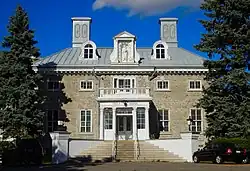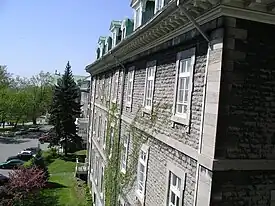Villa Maria (school)
Villa Maria is a subsidized private Catholic co-educational high school in Montreal, Quebec, Canada that offers both a francophone and an anglophone stream. Founded in 1854 as a boarding school for girls,[1] it stopped boarding students in 1966 and opened, in August 2016, to boys in the seventh grade. Today, there are roughly 950 students in the French sector and 800 students in the English sector with an average class size of 34 students.[2] Current tuition as of the 2021–2022 school year is $4,500 with $1,900 in extra mandatory fees.[3]
| Villa Maria | |
|---|---|
 'Monklands', the central building of Villa Maria, built in 1804 for Sir James Monk | |
| Location | |
Montreal, Quebec Canada | |
| Coordinates | 45.48052°N 73.619975°W |
| Information | |
| Religious affiliation(s) | Catholicism |
| Established | 1854 |
| Founder | Congregation of Notre Dame of Montreal |
| Grades | 7 to 11 |
| Gender | Originally girls only, now co-ed |
| Age range | 12 to 17 |
| Enrollment | 1750 |
| Language | French and English |
| Color(s) | Blue and yellow |
| Website | http://www.villamaria.qc.ca/ |

The central part of the Villa Maria school is known as the Monklands Mansion and was the home of the Governor General of Canada from 1844 to 1849. It is a National Historic Site of Canada.[4][5] In 2023, the Congregation of Notre Dame of Montreal announced that the estate on which the school lies will be sold off, leaving the future of the school uncertain.[6]
Monklands
In 1795, James Monk, Chief Justice of Lower Canada, purchased an estate in Montreal that had previously belonged to the Décarie family. The first Monk residence, built in 1803, was the central section of the present-day Villa Maria.
Sir James Monk willed the property known as ‘Monklands’ to his niece, Elizabeth Ann Monk. In 1844, the family leased Monklands to the Crown as a residence for the Governor General of Canada. Modifications were made to create a more imposing residence.
Three Governors General—Sir Charles Metcalfe, Lord Cathcart, and Lord Elgin—resided at Monklands. When Elgin occupied the house, British extremists threatened to burn the structure down after Elgin signed a bill that helped those of the French whose homes had been burnt down during British raids by granting them money to reestablish themselves. However, because Lady Elgin was pregnant at the time, the rebels decided to burn down the parliament building in Montreal, instead. Soon, Lady Elgin gave birth to a son, Victor Bruce, the future Viceroy of India, in a second floor room. While Montreal was serving as the capital of the Province of Canada (1844-49), Sebastien Compain turned Monklands into a country hotel.[1]
Monklands is one of the oldest remaining Palladian-style villas in Canada. Because of its excellent state of conservation and the historic importance of its various occupants, it was declared a National Historic Site in 1951.
School
During the 1840s, the Congregation of Notre Dame of Montreal's teaching order faced overcrowded classrooms and began searching for a new place.[1] The third phase of the building’s history thus began when the Congregation purchased the estate to open a boarding school. While Compain's business venture proved profitable, he agreed to give it up. Negotiations with the Monk family went smoothly. The Congregation decided to call their new school Villa Maria. It opened in 1854.[1] By the end of September that year, enrollment reached 45 girls. Of these, all were boarders, and 18 came from outside of Montreal, including Boston. While the ratio of anglophone to francophone students have changed over the years, both cultural groups have remained honoured.[1] At that time in history, Villa Maria was a leader in education in Montreal, and was visited by a number of dignitaries, starting with the future King Edward VII in 1860.[1]
The school stopped boarding students in 1966 and now is a co-educational high school for children in Montreal and surrounding areas aged 12 to 17 (or Levels 1 to 5 according to Quebec Education levels, the equivalent of Grades 7 to 11). Between 2016 and 2020, the integration of boys was gradual, with current girls-only classes staying girls-only.[7] This change was speculated to be a means of boosting enrollment, due to decreased numbers of eligible students entering the anglophone stream.[7]
The Villa-Maria metro station is named after the school.
Notable students
- Pauline Fréchette (1889–1943; graduated, 1908), poet, dramatist, journalist, nun
- Veronica Lake, American actress
- Maybelle Stephens Mitchell, American suffragist
- Jessica Pare, actress
- Anna T. Sadlier (1854–1932), writer
References
- Kalbfleisch, John (September 12, 2004). "From the archives: Villa Maria: a school with regal connections". Montreal Gazette. Archived from the original on August 4, 2023. Retrieved August 4, 2023.
- "FAQ". Collège Villa Maria.
- "Tuition Fee Structure". Collège Villa Maria.
- "Monklands / Villa Maria Convent". Directory of Designations of National Historic Significance of Canada. Parks Canada. Retrieved August 7, 2011.
- Monklands / Villa Maria Convent. Canadian Register of Historic Places. Retrieved August 7, 2011.
- "Montreal congregation of nuns to sell historic Villa Maria estate". CBC. June 21, 2023. Retrieved July 31, 2023.
- "Villa Maria girls' school to open to boys in 2016". CBC. Montréal, QC. 2015-04-26. Retrieved 2020-07-18.